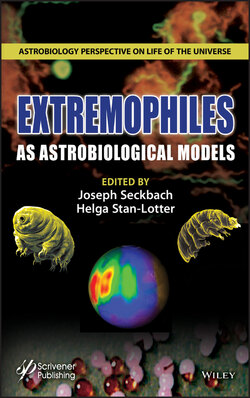Читать книгу EXTREMOPHILES as Astrobiological Models - Группа авторов - Страница 35
2.2 Acidic Chemolithotrophy
ОглавлениеNatural acidic environments are generally associated with volcanic and mining activities. In the first case sulfur chemolithotrophic microorganisms are the main players while metal and coal mining activities expose sulfidic minerals to aerobic chemolithotrophic microorganisms, facilitating their development and causing the so-called acid mine drainage (AMD) or acid rock drainage (ARD), both of which lead to serious environmental problems due to their high content of soluble heavy toxic metals [2.61] [2.62].
The mechanism by which chemolithotrophic microorganisms conserve energy using reduced sulfidic minerals has been under debate for many years [2.30]. The demonstration that ferric iron generated by iron oxidizing microorganisms is responsible for the chemical oxidation of metal sulfides has conclusively clarified this controversial issue [2.98]. We now know that the differences observed over the years in enrichment cultures using diverse metal sulfides depends on the chemical oxidation mechanism used, which is determined by the crystallographic structure of the mineral substrates. Three metal sulfides—pyrite, tungstenite and molybdenite—can be oxidized by ferric iron through the so-called thiosulfate mechanism, generating sulfuric acid [2.99]. The rest of the metal sulfides can experience ferric iron oxidation through the polysulfide mechanism, producing, in this case, elemental sulfur as final product [2.99], and requiring the additional activity of sulfur oxidizing microorganisms to generate sulfuric acid. The main players in these reactions are the iron-oxidizing microorganisms responsible for maintaining a high concentration of the chemical oxidizing agent, ferric iron.
The acidophilic strict chemolithoautotroph Acidithiobacillus ferrooxidans (formerly known as Thiobacillus ferrooxidans) was isolated for the first time in a coal mine in the middle of the last century [2.23]. Although At. ferrooxidans can obtain energy by oxidizing both reduced sulfur and iron, bioenergetic considerations ignored the role of reduced iron as an important source of energy for chemolithotrophic organisms for many years [2.90] [2.7] [2.30]. But the isolation and characterization of the strict chemolithotroph Leptospirillum ferrooxidans, which can only grow using ferrous iron as its source of energy, and the evaluation of its important role in biohydrometallurgical operations, has finally changed this point of view [2.91] [2.61] [2.48] [2.30]. In addition, it is now well-known that iron can also be oxidized in anaerobic conditions through anoxygenic photosynthesis using reduced iron as reducing power [2.106] or anaerobic respirations using nitrate as an electron acceptor [2.16], although the mechanism in this case is still very controversial [2.64] [2.20] [2.65] [2.110].
The current demonstration that subsurface chemolithotrophic microorganisms participate very actively in the dark biosphere, already predicted by Darwin almost two hundred years ago, has opened interesting perspectives not only in microbial ecology but also in astrobiology [2.52] [2.15] [2.86] [2.21] [2.111] [2.9] [2.10] [2.12] [2.87] [2.43]. There is an increasing list of alternative sources of chemolithotrophic energy (H2, , S2-, So, As3+, Mn2+, …) and possible electron acceptors for anaerobic respiration (, , , Fe3+, CO2, , Mn4+…), amplifying the metabolic versatility of this energy conservation system. Moreover, microbial iron- and sulfur-oxidizers coupled with the activity of the correspondent microbial reducers play a critical role in the operation of two critical biogeochemical cycles, the iron and sulfur cycles.
Extreme acidic environments differ significantly in their characteristics and as a consequence in their microbial ecology. High temperatures generated by biological activity facilitate the development of thermophilic and thermotolerant acidophiles. Acidic eco-systems associated with metal mining activities are, at the geological scale, rather young. Nonetheless, some mining activities, such as those in the Tinto area, which have been in exploitation for more than 5.000 years, have a somewhat relatively long history [2.68].
